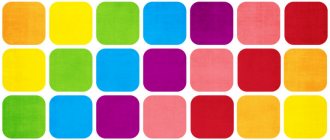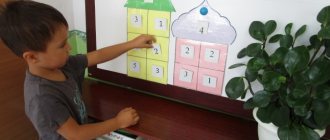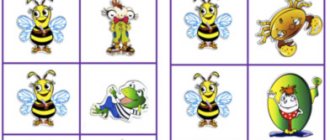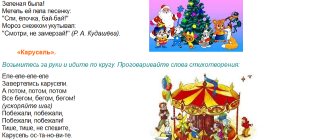Didactic games for the formation of the syllabic structure of words
The concept of “syllable structure of a word” is usually understood as the relative position and connection of syllables in a word. It is no secret that mastering the pronunciation of the syllabic structure of a word is a great difficulty for preschoolers. But mastering the syllabic structure of a word is one of the main prerequisites for mastering literacy. The lack of development of skills in syllabic analysis and synthesis entails the manifestation of dyslexia and dysgraphia during schooling.
The problem of motivation is one of the central ones in speech therapy work. Very often, knowledge of speech correction techniques and the desire of a speech therapist are not enough for the positive dynamics of children’s speech development.
It is known that the use of play techniques in correctional work prevents children from getting tired, supports their cognitive activity, and increases the effectiveness of speech therapy work in general. The words “learn by playing” remain relevant today.
A didactic game is both a method of teaching preschool children, a form of education, and a means of comprehensive education of a child’s personality.
I present to your attention didactic games, the purpose of which is to form the syllabic structure of words in preschoolers.
“When you say a word, how many syllables do you say in it?”
The first line shows numbers from one to four. On the second line are pictures whose titles have a different number of syllables.
Option 1.
The child chooses a picture and determines the number of syllables in its name. Then selects the corresponding number.
Option 2.
The child moves the first ruler so that a number appears in the window. Then it searches for a word with the appropriate number of syllables.
"Build a tower"
Modern children's construction sets offer limitless imagination not only for the child, but also for the teacher.
The children are offered object pictures with words of different syllable structures. Based on the number of syllables in a word, children build a tower from construction set parts. Then they compare the towers and determine which word is the largest and which is the smallest.
"Ladder"
Up the wonderful little staircase Now I’ll go up. I will count all the syllables, I will climb everyone higher.
Speech therapist: “Help the little people climb their steps.”
Children use pictures to determine the number of syllables in a word. They walk up the steps with their fingers, naming the syllables of the word, place the little man on the step of the last syllable, and determine the number of syllables in the word.
"Dress up the Christmas tree"
Children decorate the Christmas tree. The largest lower branches are decorated with toys with pictures, the names of which have three syllables.
Smaller branches - two-syllable words. The smallest top branches are monosyllabic words.
“Help Slogovichk”
We go with the guys to visit Slogovichok and help him collect two-syllable words - the names of toys from the halves of Kinder Surprise eggs.
We put each toy in an egg with its name.
"Snowmen"
The kids have been making a snowman since the morning. He rolls snow globes and, laughing, connects them.
The speech therapist invites children to build snowmen so that words can be read on them.
"Help the clown collect the words"
On the clock dial, instead of numbers, there are balls with syllables.
Speech therapist: “The clown was juggling balls and mixed up all the words. Help the clown collect the words."
Children move the hands of the clock, connecting syllables to form two-syllable words.
Ryabova A.M., teacher-speech therapist
- Didactic games for the development of phonemic representations and syllabic structure
- Correctional speech therapy session to overcome violations of the syllabic structure of words in 2nd grade students of a comprehensive school
- Restoration of the sound-syllable structure of a word in patients with efferent motor aphasia
- Traditional and modern methods of correcting the syllabic structure of words in children with ODD
- Didactic games and exercises for the formation of phonemic analysis in primary schoolchildren with speech disorders
( 11 liked, average score: 5.00 out of 5)
Loading...
Didactic games for the preparatory group of kindergarten
Didactic games to develop the syllabic structure of words.
Author: Budilova Galina Evgenievna, teacher, secondary school 821, preschool department.
Didactic games are intended for children in the pre-school group. Game No. 1 “Syllable Dominoes”.
For the game we will need colored cardboard, object pictures, glue, scissors, and a simple pencil. We take colored cardboard, draw the reverse side of the colored cardboard into rectangles measuring 5x10 cm.
We cut the lined sheet of cardboard into cards.
We cut out small subject pictures from old books and paste them on the colored side of the card, two at a time (left and right).
Purpose of the game: to strengthen the ability to divide words into syllables. Exercise children in determining the number of syllables in a word; in comparing the syllabic structure of various words; select pictures whose names have the same number of syllables. Develop speech, thinking, attention, phonemic hearing. Progress of the game: the child is asked to look at the cards - dominoes and lay out a chain of dominoes so that the number of syllables of the next word - name coincides with the number of syllables of the previous one. If the task is completed correctly, the chain will be closed, that is, the syllable structure of the name of the next picture will coincide with the syllable structure of the first.
Game No. 2 “Flower Shop”.
To make the game we will need postcards, colored cardboard, glue, scissors, and a pencil. We take colored cardboard, and on the back side we draw the cardboard into rectangles measuring 14x10 cm.
Cut the cardboard into rectangles.
We glue flower cards onto the colored side of the cardboard rectangles.
We take cardboard of a different color, draw the back side of the cardboard into rectangles measuring 3x8 cm.
Cut the cardboard into cards.
Glue circles on the colored side of the cards (1, 2, 3, 4).
Purpose of the game: to consolidate the ability to divide words into syllables, to consolidate the names of colors in the children's dictionary. Develop speech, thinking, attention, phonemic hearing. How to play: Place cards with flowers on the typesetting canvas. The teacher says: “This is our flower shop, it sells different flowers. Some have short names, for example: peony; others with long names, for example: forget-me-nots. You each have a number card with circles. This is money". You will be the buyers, and I will be the seller. The buyer can only buy that flower whose name has as many parts (syllables) as there are circles on the card. You will come to the store, present a number card and say the name of the flower in parts. If you correctly determine which flower you can buy, you will receive it; if you are wrong, the flower remains on the counter.” At the end of the game, the teacher shows a number card and asks to name the purchased flowers, the names of which have as many syllables as there are circles on the card.
Game No. 3 “Three Lines”
For the game you will need colored cardboard, object pictures, scissors, glue, pencil. Take a sheet of cardboard and divide it into three parts.
We take another sheet of cardboard and draw it on the reverse side into squares with a side of 5 cm.
Cut the cardboard into squares.
We paste object pictures onto the squares.
Purpose of the game: to train children in dividing words into syllables; determining the number of syllables in a word; find pictures whose titles have a certain number of syllables. Develop children's speech, cultivate attention and thinking. Progress of the game: children are given large cards, divided into three parts and subject pictures. Children should place pictures on the first line whose names consist of one syllable; on the second line put pictures whose names consist of two syllables; on the third - of three syllables.
We recommend watching:
Didactic game with sounding objects for older preschoolers Didactic game for teaching literacy to older preschoolers Didactic game for teaching literacy to older preschoolers Lesson on speech development in the preparatory group. Spring
Similar articles:
Summary of an integrated educational activity in the preparatory group of children with a compensatory orientation “Visiting Winter”
Story-based didactic game for older preschoolers “We are traveling on a train”
Didactic games to familiarize yourself with flora and fauna for children of the senior preparatory group






